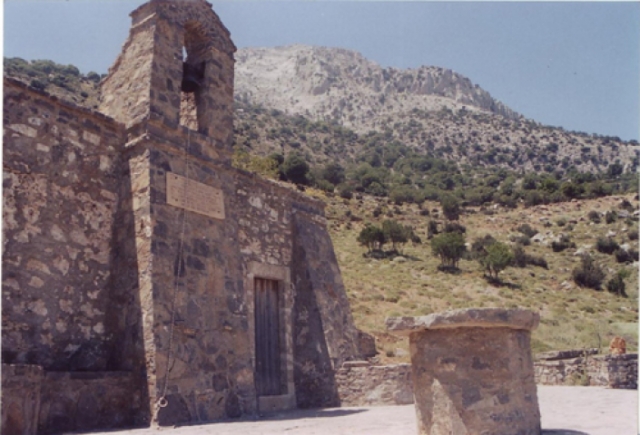Your Position:
Unknown
Λεπτομέρειες ΕικόναςImage details
More Photos
Press here.
Places near Church
Zominthos (Greek: Ζώμινθος, alternative spellings Ζόμινθος or Ζόμιθος) is a small plateau in the northern foothills of Mount Ida (Psiloritis), οn the island of Crete. Zominthos is roughly 7.5 kilometers west of the village of Anogia, on the path from Knossos to Idaion Andron, the great sanctuary cave near the peak of Ida. Zominthos is best known for the large Minoan building discovered there; signs of permanent settlement date back to about 1800 BC.
Professor Yannis Sakellarakis discovered the site in 1982, during his first day of excavations at the nearby Ideon Andron Cave by Psiloritis mountain, close to Anogia Village, when a shepherd told him about his pastures and sheep in an area called “Zominthos.”
Intrigued by the pre-Hellenic place-name, he began small-scale excavations the following year, which revealed the Central Building that is now believed to have dominated one of the main Minoan routes up to Mount Ida, today called Psiloritis. Zominthos may have been used as a rest stop for visitors making their way from Knossos to the Ideon Cave, the great sanctuary cave near the peak of Ida, as is mentioned in Plato’s Laws (book I, 625B): “I dare say that you will not be unwilling to give an account of your government and laws; on our way we can pass the time pleasantly in and about them, for I am told that the distance from Knossos to the cave and the temple of Zeus is considerable; and doubtless there are shady places under the lofty trees, which will protect us from this scorching sun.”
Zominthos seems to have been occupied beginning the 17th century B.C., with an extensive settlement and a monumental Central Building that covers an area of 1,600 square meters (17,000 square feet). Beneath the Central Building, which was gradually developed from the 17th century onward, the remains of several earlier structures have been identified. Because of the severe climate conditions on the mountaintop—including snow during the winter months—the site may not have been used throughout the entire year, but rather as a seasonal habitat. During the summer months, people likely moved their flocks of sheep here, to higher altitudes, while exploiting natural resources, such as minerals, herbs, and pharmaceutical plants. These products, along with woolen textiles and olives, were the goods most commonly exported from Minoan Crete to Egypt and the Middle East.
The Central Building is extremely well preserved and some of its walls still stand at a height of 2.2 meters (7.2 feet). However, creating the foundation of such a huge building at this altitude is quite a complicated issue. Its unlikely location and size, as well as its careful construction, indicate the existence of a central authority that intended to control the region’s resources, including its flocks and pastures. Zominthos may therefore be considered a well-organized administrative complex—built on a strategic spot for the control of the area—that fully adapted to the inhospitable Cretan mountains. Its location on the ancient route to Psiloritis and the wealth of pottery found at the site indicate that it was likely also a religious and crafts center.
The accounting archives in the Linear B script from the palace at Knossos—about 40 kilometers (25 miles) from Zominthos—record thousands of sheep along with shepherds’ names. However, the location of the land where these sheep were grazing has always been a mystery. Zominthos and the neighboring regions have very prosperous pastures, so it could be that the sheep recorded in the Knossos tablets were mainly concentrated here at Zominthos. The Central Building’s importance is confirmed by its asymmetrical facades and orientation to the cardinal points, which are well-known characteristics of Minoan palaces. Zominthos was destroyed by an earthquake around 1600 B.C., which resulted in a fire that devastated the vast majority of building’s structure. But various finds from the Central Building indicate that the site continued to be used in Mycenaean, Archaic, Hellenistic, and Roman times.
After a gap of 17 years, archaeological work at the site of Zominthos resumed in the summer of 2005. Although only the ground floor is visible today, archaeological evidence suggests that the Central Building had at least two floors built of large blocks of local stone, some coated with white plaster and decorated with frescoes. Only 10 of at least 45 rooms of the ground floor have been partly or fully explored up to now, and the results can be summarized as follows: The rooms contained pottery, masses of animal bones, numerous fragments of carbonized wood, and several small artifacts. The vast majority of the pottery includes conical cups, cooking pots, and pithoi. Also, several ceramic water conduits have been found, probably indicating a central drainage system. In the western part of the Central Building, a complex consisting of at least two workshops was discovered.
The plateau Livadi, at a height of 1,020 meters, covers a surface of 1,000 hectares. It is located 10km west of the village Kroussonas, Heraklion Prefecture and 37km southwest of Heraklion Town, on the eastern slopes of Psiloritis Mountain. Agriculture and stock-raising are the main activities of its inhabitants: their dairy products, livestock and fruit (apples, pears, walnuts, prunes, among others) are of excellent quality. The Livadi plateau, of Kroussonas is a real orchard with 300,000 pear-trees and some apple-trees. The Livadi is a beautiful place, well worth a visit in the summer. From here you can admire the Kroussonas Gorge which goes from the village of Kitharida all the way to Zomintho an ancient source on the Psiloritis Mountain. It is said that the Minoans followed this gorge to reach the "Ideon Andron", the cave where Zeus was born, and one can still see traces of this ancient passage.
The mountainous municipality of Kroussonas includes the village of Kroussonas, that of Kitharida and the monastery of Agia Irini. Its total population amounts to 3,071 inhabitants; the municipality covers 7,000 hectares of which 1,500 are wooded land (cypresses, cedars, oaks, and so on).
The mountainous municipality of Kroussonas includes the village of Kroussonas, that of Kitharida and the monastery of Agia Irini. Its total population amounts to 3,071 inhabitants; the municipality covers 7,000 hectares of which 1,500 are wooded land (cypresses, cedars, oaks, and so on).







